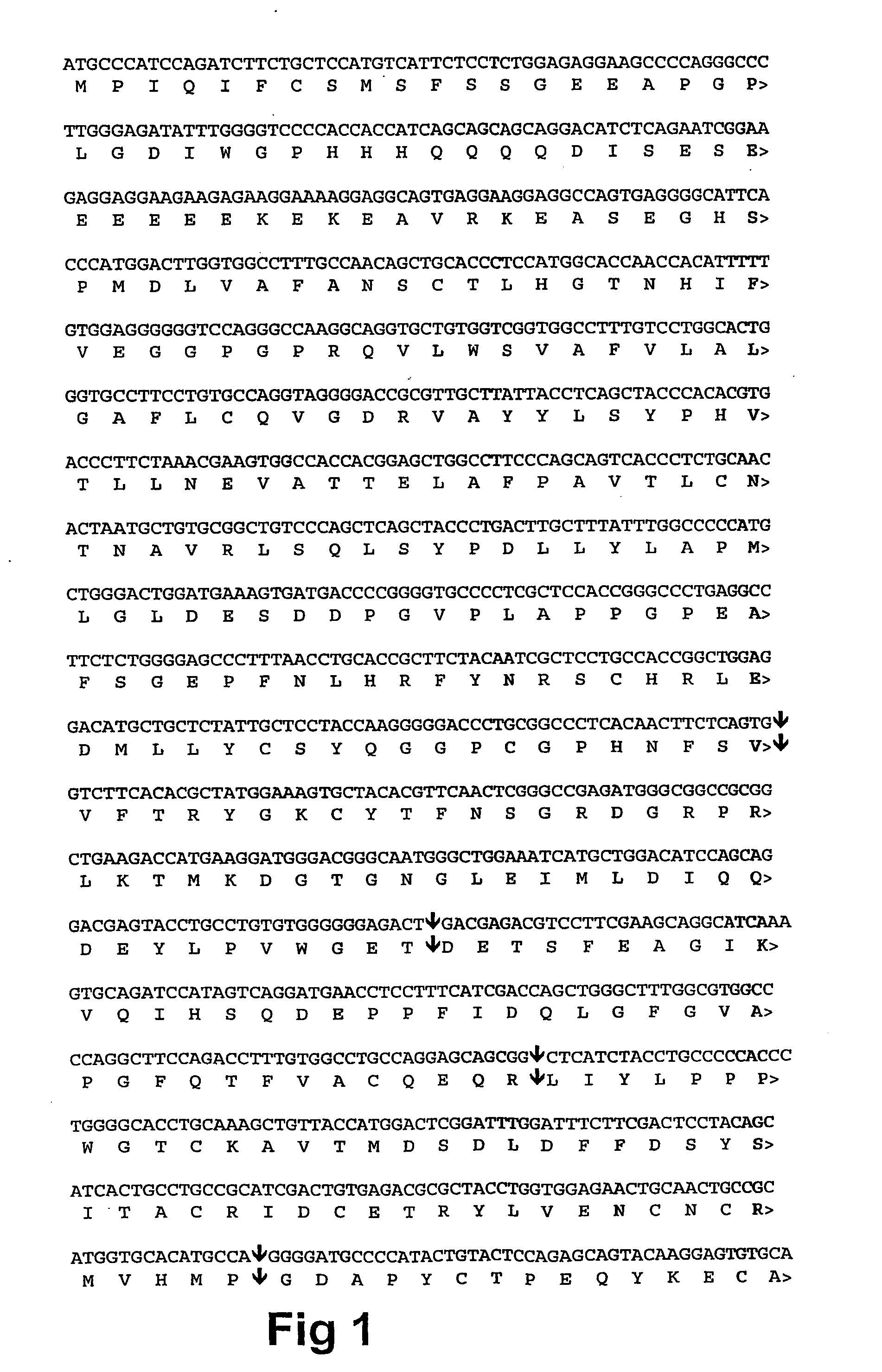Novel human proton-gated channels
a proton-gated channel and human technology, applied in the field of new human proton-gated channels, can solve the problem of unpredictable actual functional characteristics of the new splice variants
- Summary
- Abstract
- Description
- Claims
- Application Information
AI Technical Summary
Problems solved by technology
Method used
Image
Examples
example 1
Cloning of Full Length cDNA Encoding the hASIC1B Protein
[0172] A blast search of the entire GenBank database using selected polypeptide motifs caracteristic of rat ASIC1B N-terminal polypeptide, retrieved a human genomic polynucleotide molecule (GenBank accession: AC025154, AC074032, AC025361). Subsequent methodological analysis of the above cited genomic DNA sequence based on sequence comparison and alignment with cloned ASIC family members as well as consensus intron / exon splicing sites allowed the identification of a cDNA sequence encoding a novel human ASIC subunit, herein named hASIC1B. The alignment with the published rat ASIC1b immediately revealed that both receptors differed at the 5-prime end and that the initiating methionine on the human receptor was not evident. The identified human sequence contained three potential initiation sites (see FIG. 1 ) and accordingly three putative hASIC1B constructs were prepared. Functional analysis revealed that only the longest version...
example 2
Labeling and Use of Hybridization Probes
[0173] Hybridization probes derived from SEQ ID NO: 1 are employed to screen cDNAs, genomic DNAs, or mRNAs. Although the labeling of oligonucleotides, consisting of about 20 base-pairs, is specifically described, essentially the same procedure is used with larger cDNA fragments. Oligonucleotides are designed using state-of-the-art software such as GeneWorks 2.5.1 (Oxford Molecular), labeled by combining 50 pmol of each oligomer and 250 μCi of γ32P adenosine triphosphate (Amersham) and T4 polynucleotide kinase (DuPont NEN, Boston, Mass.). The labeled oligonucleotides are substantially purified with Sephadex G-25 superfine resin column (Pharmacia & Upjohn). Labelled sense and antisense oligonucleotides are then used in a typical membrane based hybridization analysis of human genomic DNA digested with one of the following endonucleases (Ase I, Bgl II, Eco RI, Pst I, Xba I or Pvu II; DuPont NEN).
[0174] The DNA from each digest is fractionated on...
example 3
Northern Blot Analysis
[0175] Northern analysis is a laboratory technique used to detect the presence of a transcript of a gene and involves the hybridization of a labeled nucleotide sequence to a membrane on which RNAs from a particular cell type or tissue have been bound (Sambrook et al., supra).
[0176] Northern blots containing 2 μg of poly(A)+RNA isolated from specific adult human tissues or from sections of the brain are obtained from commercial sources (Clontech). Probes are prepared by random prime labeling (Pharmacia Biotech Inc.), or as described above. PCR primers (SEQ ID NO: 5 and SEQ ID NO: 6) specific for the 5′ and 3′ ends of the protein coding sequence of the first exon of hASIC1B cDNA were used in a PCR reaction to generate a fragment containing the entire hhASIC1B-specific sequence. This fragment was cloned into the pBluescript vector and used to probe the multiple tissue blots. Filters were hybridized overnight at 42° C. in a buffer containing 50% formamide, 5×SSPE...
PUM
| Property | Measurement | Unit |
|---|---|---|
| Tm | aaaaa | aaaaa |
| Tm | aaaaa | aaaaa |
| temperatures | aaaaa | aaaaa |
Abstract
Description
Claims
Application Information
 Login to View More
Login to View More - R&D
- Intellectual Property
- Life Sciences
- Materials
- Tech Scout
- Unparalleled Data Quality
- Higher Quality Content
- 60% Fewer Hallucinations
Browse by: Latest US Patents, China's latest patents, Technical Efficacy Thesaurus, Application Domain, Technology Topic, Popular Technical Reports.
© 2025 PatSnap. All rights reserved.Legal|Privacy policy|Modern Slavery Act Transparency Statement|Sitemap|About US| Contact US: help@patsnap.com



